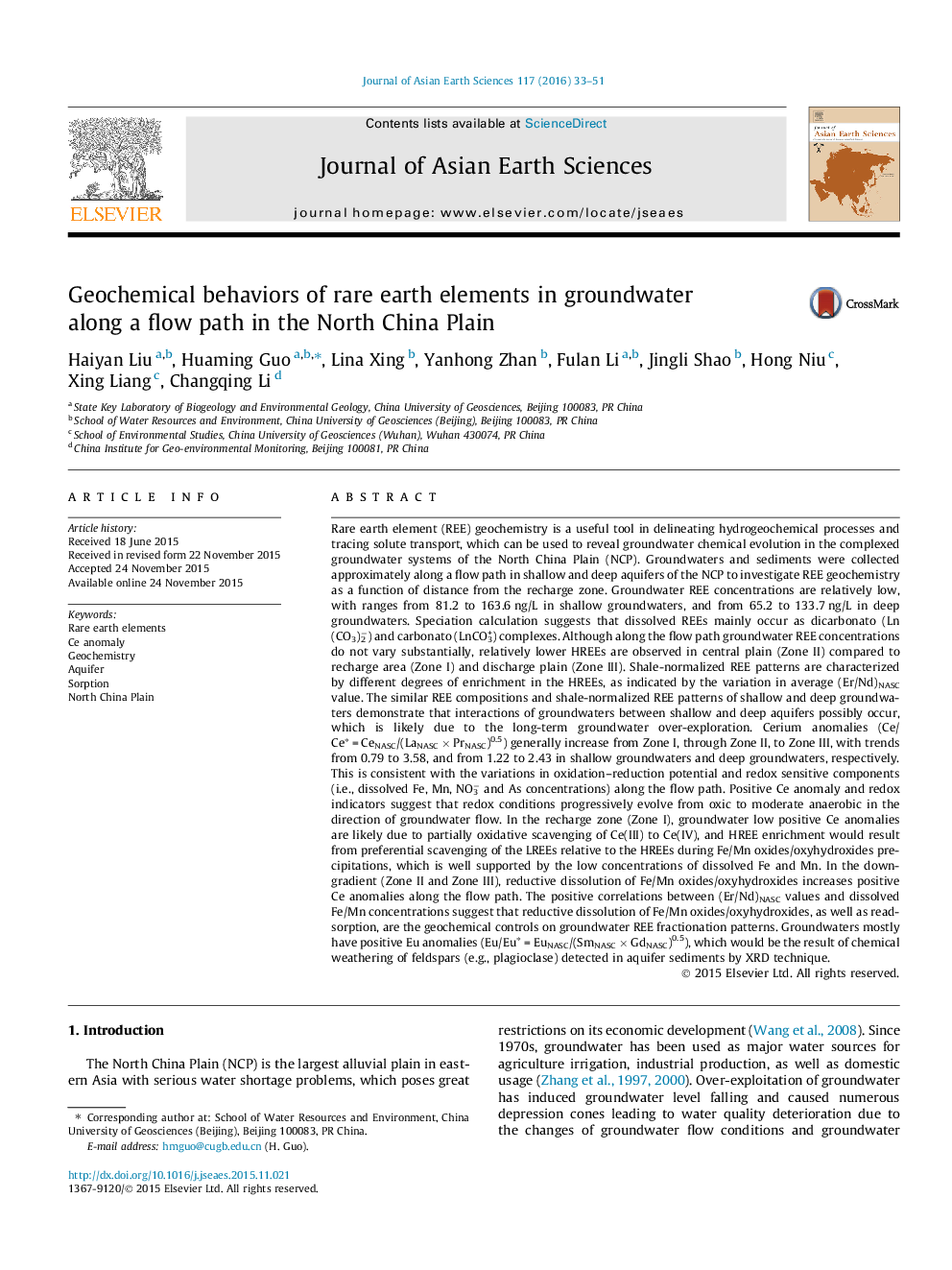| کد مقاله | کد نشریه | سال انتشار | مقاله انگلیسی | نسخه تمام متن |
|---|---|---|---|---|
| 4730173 | 1640354 | 2016 | 19 صفحه PDF | دانلود رایگان |
• Increasing Ce anomaly along a flow path would be related to changing redox conditions.
• REE geochemistry is associated with precipitation and dissolution of Fe/Mn oxides.
• Europium anomaly would result from weathering of plagioclase in aquifer sediments.
• REEs are useful as tracers of groundwater flow conditions and geochemical processes.
Rare earth element (REE) geochemistry is a useful tool in delineating hydrogeochemical processes and tracing solute transport, which can be used to reveal groundwater chemical evolution in the complexed groundwater systems of the North China Plain (NCP). Groundwaters and sediments were collected approximately along a flow path in shallow and deep aquifers of the NCP to investigate REE geochemistry as a function of distance from the recharge zone. Groundwater REE concentrations are relatively low, with ranges from 81.2 to 163.6 ng/L in shallow groundwaters, and from 65.2 to 133.7 ng/L in deep groundwaters. Speciation calculation suggests that dissolved REEs mainly occur as dicarbonato (Ln(CO3)2−) and carbonato (LnCO3+) complexes. Although along the flow path groundwater REE concentrations do not vary substantially, relatively lower HREEs are observed in central plain (Zone II) compared to recharge area (Zone I) and discharge plain (Zone III). Shale-normalized REE patterns are characterized by different degrees of enrichment in the HREEs, as indicated by the variation in average (Er/Nd)NASC value. The similar REE compositions and shale-normalized REE patterns of shallow and deep groundwaters demonstrate that interactions of groundwaters between shallow and deep aquifers possibly occur, which is likely due to the long-term groundwater over-exploration. Cerium anomalies (Ce/Ce∗ = CeNASC/(LaNASC × PrNASC)0.5) generally increase from Zone I, through Zone II, to Zone III, with trends from 0.79 to 3.58, and from 1.22 to 2.43 in shallow groundwaters and deep groundwaters, respectively. This is consistent with the variations in oxidation–reduction potential and redox sensitive components (i.e., dissolved Fe, Mn, NO3− and As concentrations) along the flow path. Positive Ce anomaly and redox indicators suggest that redox conditions progressively evolve from oxic to moderate anaerobic in the direction of groundwater flow. In the recharge zone (Zone I), groundwater low positive Ce anomalies are likely due to partially oxidative scavenging of Ce(III) to Ce(IV), and HREE enrichment would result from preferential scavenging of the LREEs relative to the HREEs during Fe/Mn oxides/oxyhydroxides precipitations, which is well supported by the low concentrations of dissolved Fe and Mn. In the down-gradient (Zone II and Zone III), reductive dissolution of Fe/Mn oxides/oxyhydroxides increases positive Ce anomalies along the flow path. The positive correlations between (Er/Nd)NASC values and dissolved Fe/Mn concentrations suggest that reductive dissolution of Fe/Mn oxides/oxyhydroxides, as well as readsorption, are the geochemical controls on groundwater REE fractionation patterns. Groundwaters mostly have positive Eu anomalies (Eu/Eu∗ = EuNASC/(SmNASC × GdNASC)0.5), which would be the result of chemical weathering of feldspars (e.g., plagioclase) detected in aquifer sediments by XRD technique.
Journal: Journal of Asian Earth Sciences - Volume 117, 1 March 2016, Pages 33–51
